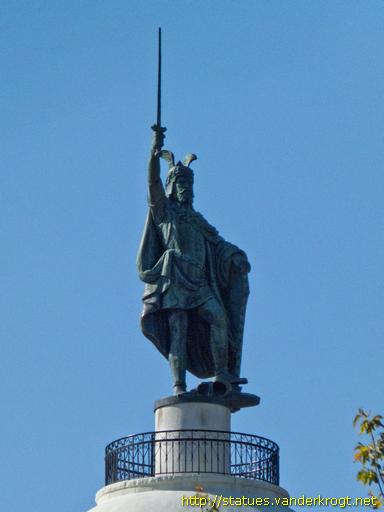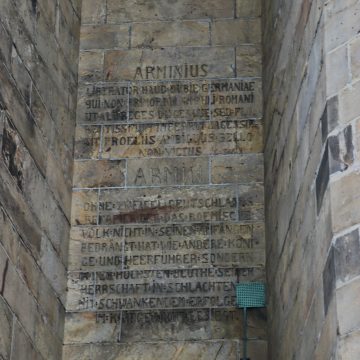
New Ulm has continued to restore the monument, adding four cast iron lions, part of Julius Berndt’s original design, to the base in 2001 and removing the statue in 2004 to make further repairs. Jesse Ventura cited this project, which he viewed as government waste, as one of the reasons for his decision to run for governor. The structure underwent significant repairs in 1999 with support from the Minnesota legislature. In 1929, the City of New Ulm took over the site from the Sons of Hermann. The base houses a small museum on Hermann and the history of the monument. From a platform beneath Hermann’s feet, visitors can view the Minnesota River Valley. Ten pillars circle an open base with a spiral staircase in the middle that leads to the cupola. Only New York City’s Statue of Liberty (151 feet) and Portlandia (almost thirty-four feet) in Portland, Oregon, are taller than Hermann (thirty-two feet from sword tip to toe). One of the largest copper-sheet statues in the United States, Hermann looks out over the town of New Ulm, a sword in his right hand, a shield in his left hand, and a foot placed firmly on a Roman helmet. The foundation, base, cupola, and statue together reach a height of 102 feet. Speakers extolled Hermann as a freedom fighter, in part in response to the growing prohibition movement, which disapproved of the German tradition of beer drinking. Special trains brought crowds to New Ulm for the festivities. The town celebrated with weeklong events and a special beer, Hermann’s Brau. On September 25, 1897, the Sons of Hermann dedicated the monument at its national meeting, held in New Ulm. Although completed in 1889, the sculpture sat in storage for several years while Berndt raised enough money from individuals and Sons of Hermann lodges to finish the base. Mullins Manufacturing Company in Salem, Ohio, made the statue from copper sheeting over a steel frame.Īfter debate over the location, a cornerstone was laid in New Ulm on June 24, 1888. An architect and founding members of the Sons’ New Ulm chapter, Berndt designed the monument himself. Julius Berndt, one of the founders of New Ulm, persuaded a German American group, the Sons of Hermann, to fund a similar work to show pride in their ethnic heritage. The Detmold sculpture inspired Germans on the other side of the Atlantic.

(Evidence now points to Kalkriese, a hill in Lower Saxony, Germany, as the site of the battle.) In 1875, sculptor Joseph Ernst von Bandel completed a large monument to Hermann near Detmold, Germany, where he thought the battle had taken place.

By the nineteenth century, Hermann had become a symbol of a strong, united country for Germans eager to define a national identity. In Germany, Arminius gained folk hero status (and the name of Hermann) over the centuries.

Arminius brought together several tribes under his rule until his death about a decade after his victory. As a result, Rome gave up trying to conquer German lands east of the Rhine. According to Roman sources, in September, 9 CE, Arminius led three Roman legions into a trap and defeated them. A member of the Cherusci tribe of Germania, the historical Hermann (or Arminius, as the Romans called him) served in the Roman Army. Known locally as “Hermann the German,” the heroic figure stands ready to fight atop a dome in Hermann Heights Park in New Ulm. Built in 1897 with funds raised from Sons of Hermann lodges all over the country, the monument is now owned by the City of New Ulm.

This copper-sheet sculpture reflects the pride the early German American immigrants to Minnesota felt in their cultural background. On the bluffs above New Ulm stands a statue of Hermann, a first-century German chieftain who triumphed over Rome.


 0 kommentar(er)
0 kommentar(er)
